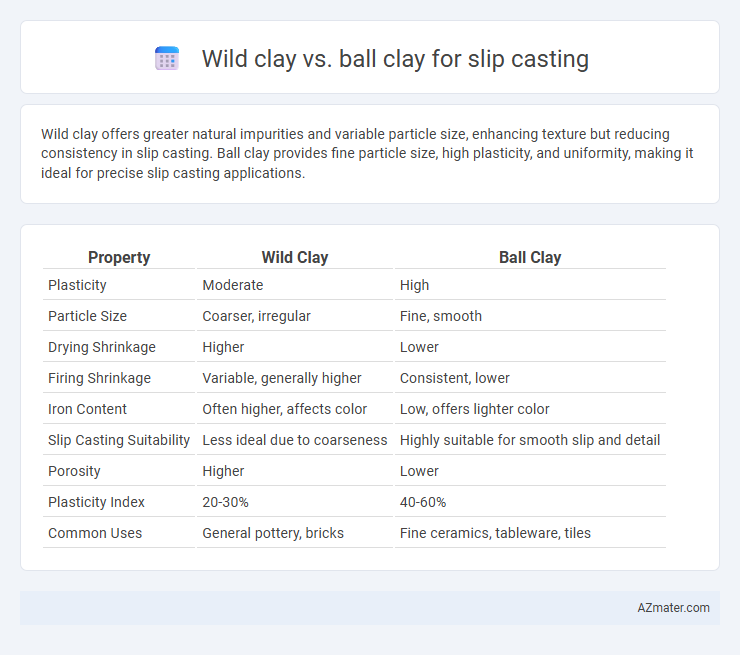Wild clay offers greater natural impurities and variable particle size, enhancing texture but reducing consistency in slip casting. Ball clay provides fine particle size, high plasticity, and uniformity, making it ideal for precise slip casting applications.
Table of Comparison
| Property | Wild Clay | Ball Clay |
|---|---|---|
| Plasticity | Moderate | High |
| Particle Size | Coarser, irregular | Fine, smooth |
| Drying Shrinkage | Higher | Lower |
| Firing Shrinkage | Variable, generally higher | Consistent, lower |
| Iron Content | Often higher, affects color | Low, offers lighter color |
| Slip Casting Suitability | Less ideal due to coarseness | Highly suitable for smooth slip and detail |
| Porosity | Higher | Lower |
| Plasticity Index | 20-30% | 40-60% |
| Common Uses | General pottery, bricks | Fine ceramics, tableware, tiles |
Introduction to Slip Casting
Slip casting requires carefully selected clays with specific plasticity and particle size distributions to achieve a smooth, consistent slip. Wild clay often contains impurities and inconsistent particle sizes, resulting in less predictable drying and firing behavior, whereas ball clay is prized for its fine particle size, high plasticity, and ability to improve the workability and strength of the slip. Using ball clay in slip casting formulations enhances the casting performance and surface quality of ceramic parts due to its uniformity and controlled mineral composition.
What is Wild Clay?
Wild clay refers to naturally occurring clay deposits that have not undergone industrial processing or purification, containing a mix of minerals and organic materials. In slip casting, wild clay offers unique texture and plasticity but can introduce impurities affecting the consistency and strength of the final ceramic piece. Compared to ball clay, which is highly refined and prized for its fine particle size and high plasticity, wild clay requires more careful handling and testing to achieve optimal slip casting results.
Understanding Ball Clay
Ball clay, a highly plastic and fine-grained sedimentary clay, is prized in slip casting for its excellent binding properties and smooth texture, enhancing the slip's workability and green strength. Unlike wild clay, which often contains higher impurities and less plasticity, ball clay contributes to improved drying shrinkage control and surface finish in ceramic products. Its consistent particle size distribution and purity make ball clay an essential additive in formulating high-quality slips for precise and defect-free casting.
Key Properties: Wild Clay vs Ball Clay
Wild clay for slip casting typically exhibits higher plasticity and coarser particle size compared to ball clay, which offers superior fineness and whiteness. Ball clay's lower impurity levels and better filtration properties enhance slip fluidity and improve surface finish in casting processes. The choice between wild clay and ball clay directly impacts drying shrinkage, green strength, and fired ware quality in ceramic production.
Sourcing and Preparation Comparisons
Wild clay is sourced directly from natural deposits, often containing impurities requiring extensive cleaning and sieving before slip casting, whereas ball clay is mined from well-defined sedimentary beds with consistent particle size and fewer contaminants. Preparation of wild clay involves additional processing steps, such as weathering and refining to achieve plasticity, while ball clay typically requires minimal refinement due to its naturally fine particles and high plasticity. The consistent quality and purity of ball clay make it preferable for slip casting, providing smoother slips and improved workability compared to the variable nature of wild clay.
Plasticity and Workability Differences
Wild clay typically offers higher plasticity compared to ball clay due to its natural mineral composition, enhancing its ability to be easily molded during slip casting. Ball clay is valued for its fine particle size and smooth texture, providing excellent workability and consistency in slip casting applications. The combination of wild clay's plasticity and ball clay's workability can optimize the casting process, improving green strength and surface finish in ceramic products.
Firing Results: Strength and Color Variations
Wild clay in slip casting often produces varied firing results due to its heterogeneous mineral content, leading to unpredictable color shifts and inconsistent strength. Ball clay, rich in kaolinite and fine particles, typically offers uniform firing strength with consistent off-white to cream color tones. The choice between wild clay and ball clay directly affects the mechanical durability and aesthetic outcomes of the final slip cast piece.
Environmental Impact and Sustainability
Wild clay for slip casting often presents lower environmental impact due to minimal processing requirements and local sourcing, reducing carbon emissions. Ball clay, while highly plastic and ideal for slip casting, typically involves intensive mining and refining processes that contribute to habitat disruption and higher energy consumption. Sustainable slip casting initiatives prioritize wild clay usage and incorporate recycling strategies to minimize waste and ecological footprint.
Cost and Accessibility of Wild vs Ball Clay
Ball clay is generally more cost-effective and widely accessible than wild clay due to its consistent quality and large-scale mining operations. Wild clay often comes with higher variability in composition, which can increase processing costs and limit availability for slip casting applications. Manufacturers typically prefer ball clay for its reliable supply and lower expense, making it the economical choice in ceramic production.
Choosing the Right Clay for Slip Casting
Wild clay often contains more impurities and variable particles, affecting the smoothness and strength of slip casts, while ball clay is prized for its fine particle size, plasticity, and excellent binding properties, making it ideal for slip casting. Selecting the right clay depends on the desired finish and structural integrity; ball clay provides consistent workability and shrinkage control, essential for precise slip-cast molds. Understanding the mineral composition and plasticity index of each clay type ensures optimal flow and drying characteristics, resulting in high-quality ceramic products.

Infographic: Wild clay vs Ball clay for Slip casting
 azmater.com
azmater.com